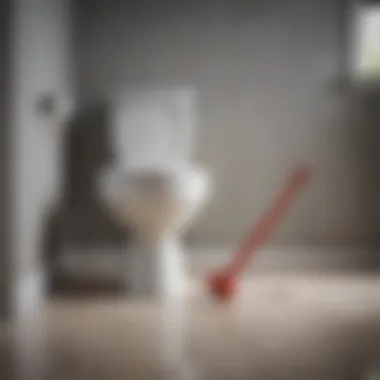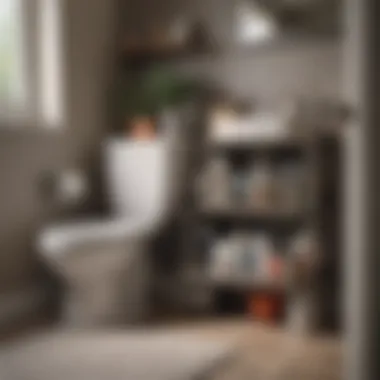Mastering the Art of Toilet Snaking: A Comprehensive Step-by-Step Guide


Inspiring Homes
Toilet issues are a common headache for homeowners, often requiring immediate attention to prevent further damage and maintain a functional living space. Among the various plumbing predicaments, toilet blockages stand out as a frequent occurrence that demands a prompt resolution. In this comprehensive guide, we delve into the intricacies of snaking a toilet effectively, equipping readers with the necessary knowledge and skills to address this issue with confidence and efficiency.
When encountering a clogged toilet, many individuals resort to plungers as their first line of defense. However, in cases where plunging proves ineffective, employing a plumbing snake, also known as an auger, becomes imperative. A plumbing snake is a flexible tool designed to navigate through the curves of the toilet drain, dislodging any obstructions in its path. Understanding how to navigate this device through the piping system is essential to successfully unclogging the toilet and restoring smooth functionality.
Stunning Locations
Before embarking on the journey of snaking a toilet, it is crucial to familiarize oneself with the anatomy of the toilet at hand. A typical toilet comprises the bowl, the trap, and the drain. The bowl is the visible part where the flushing occurs, while the trap lies beneath and connects the bowl to the drain, which leads to the sewer or septic tank. By comprehending these components and their interplay, individuals gain a deeper insight into the obstruction's likely location and the most effective approach to tackle it. This foundational knowledge sets the stage for a methodical and successful snaking process.
Interior Design Trends
To commence the snaking procedure, equip yourself with the essential tools required for the task. These include a plumbing snake, rubber gloves, protective eyewear, and possibly a drain snake or toilet auger. With these tools in hand, you are prepared to confront the clog head-on and restore your toilet to its fully operational state. Adhering to safety protocols by wearing protective gear ensures a secure and hygienic snaking experience.
Once the necessary tools are in place, the next step involves inserting the plumbing snake into the toilet drain. Care must be taken to guide the snake gradually and steadily through the pipes, avoiding any forceful movements that could worsen the blockage or damage the plumbing system. By maintaining a patient and methodical approach, individuals maximize the snake's effectiveness in dislodging the obstruction and clearing the passage for uninterrupted water flow.
After successfully navigating the snake through the drain and encountering the blockage, gentle maneuvering and rotation of the tool aid in breaking up the obstruction. By employing strategic movements and gentle pressure, the snake effectively engages with the clog, loosening its grip on the piping and facilitating its removal. Patience and precision are key during this phase, as hasty actions may result in a more entrenched blockage or potential damage to the toilet structure.
Upon dislodging the obstruction, gradual extraction of the plumbing snake from the drain is necessary to ensure complete removal of the clog. Careful retraction helps prevent any remnants of the blockage from lingering within the pipes, reducing the likelihood of future clogs and ensuring smooth water passage in the toilet system. Thorough removal of the snake, coupled with a final flush to test the water flow, signifies the completion of the snaking process and the successful resolution of the toilet blockage.
Final Thoughts
Introduction
Toilet snaking is a critical skill every homeowner should possess. This article aims to equip you with a comprehensive understanding of how to effectively snake a toilet, ensuring you can address common plumbing issues confidently and independently. By delving into the tools required and step-by-step techniques, you will be able to navigate this essential aspect of home maintenance with ease.
Understanding the Importance of Toilet Snaking
Preventing Clogs
When it comes to maintaining a functional bathroom, preventing clogs is paramount. By using the method of toilet snaking, you can proactively tackle blockages before they escalate into major plumbing problems. The unique feature of preventing clogs through snaking lies in its ability to target and remove obstructions deep within the pipes, ensuring a smooth and uninterrupted flow. This technique not only saves you from the nuisance of frequent clogs but also contributes to the overall longevity of your plumbing system.
Maintaining Proper Functionality
Maintaining proper functionality through toilet snaking is a key aspect of preserving the efficiency of your bathroom fixtures. This process involves regular upkeep and cleaning of the drains to prevent buildup and blockages. By incorporating snaking into your maintenance routine, you ensure that water flows effortlessly, toilets flush properly, and potential issues are nipped in the bud. The advantage of this approach is that it promotes a proactive rather than reactive stance towards plumbing maintenance, ultimately saving you time, money, and potential headaches.
Avoiding Costly Repairs
By embracing toilet snaking as a preventive measure, you can significantly reduce the likelihood of costly repairs down the line. Regularly eliminating blockages and keeping your plumbing system free from obstructions mitigates the risk of major malfunctions that could necessitate professional intervention. The benefit of avoiding costly repairs through snaking lies in its simplicity and cost-effectiveness, making it a smart investment in the long-term health of your home.


Tools Required for Toilet Snaking
Plumbing Snake
The plumbing snake, also known as an auger, is a fundamental tool for effective toilet snaking. Its design allows it to navigate through the pipes, dislodging and removing blockages with precision. The key characteristic of the plumbing snake is its flexibility, enabling it to reach deep into plumbing systems to target clogs at their source. This tool's unique feature lies in its ability to clear obstructions without causing damage to the pipes, making it a popular choice for DIY enthusiasts.
Rubber Gloves
Rubber gloves are an essential safety component when engaging in toilet snaking. Their primary function is to protect your hands from coming into direct contact with waste and potentially harmful bacteria. The key characteristic of rubber gloves is their durability and resistance to punctures, providing a reliable barrier during maintenance tasks. The unique feature of rubber gloves is their ease of use and disposal, offering a hygienic solution for handling sanitation-related chores.
Protective Eyewear
Protective eyewear plays a crucial role in maintaining safety during toilet snaking operations. Its main function is to shield your eyes from splashes, debris, and chemicals that may be present in the plumbing system. The key characteristic of protective eyewear is its impact resistance and coverage, ensuring maximum protection during tasks. The unique feature of this gear is its lightweight and comfortable design, making it a practical choice for extended use in potentially hazardous environments.
Safety Precautions
Turning Off Water Supply
Before initiating any toilet snaking procedure, it is essential to turn off the water supply to prevent accidental flooding or leaks. The key characteristic of this safety measure is its ability to minimize the risk of water damage and ensure a controlled working environment. Turning off the water supply is a beneficial choice for this article as it sets the foundation for a safe and efficient snaking process. The unique feature of this precaution is its simplicity yet critical role in preventing potential mishaps.
Proper Ventilation
Ensuring proper ventilation during toilet snaking activities is vital for maintaining a healthy indoor environment. Improved air circulation helps dissipate odors and airborne particles, enhancing overall comfort and safety. The key characteristic of proper ventilation is its ability to reduce the concentration of harmful fumes and contaminants in enclosed spaces. This choice is advantageous for this article as it promotes a conducive work environment and minimizes respiratory risks. The unique feature of proper ventilation is its role in promoting overall well-being during home maintenance tasks.
Using Caution with Tools
Exercise caution when handling tools during toilet snaking to prevent injuries and damages. The key characteristic of using caution with tools is its emphasis on safety and precision, reducing the likelihood of accidents. This approach is a beneficial choice for this article as it underscores the importance of attentiveness and skill when working on plumbing systems. The unique feature of this precaution is its proactive stance on accident prevention, promoting a secure and efficient snaking process.
Step-by-Step Guide
Toilet snaking is a crucial skill that every homeowner should possess. This detailed guide will take you through the step-by-step process of effectively snaking a toilet, ensuring that you can tackle this common plumbing issue with confidence. By following the instructions outlined in this section, you will not only be able to resolve clogs but also maintain the proper functionality of your toilet, ultimately avoiding costly repairs. Investing your time in mastering the art of toilet snaking will undoubtedly prove beneficial in the long run.
Preparing the Area
Clearing the Surrounding Area
Clearing the surrounding area is essential before embarking on snaking your toilet. By removing any obstacles or unnecessary items near the toilet, you create a clear working space that allows for easier access to the plumbing fixtures. This step is crucial in ensuring that you have sufficient room to maneuver the plumbing snake effectively, increasing your chances of success in clearing the blockage. While it may seem like a simple task, clearing the surrounding area sets the foundation for a seamless snaking process, making the overall experience more efficient and hassle-free.
Laying Down Towels or Newspapers
When preparing to snake a toilet, laying down towels or newspapers serves as a protective measure against potential mess and wastewater spills. These materials act as a barrier between the floor and any dislodged debris that may come out during the snaking process. By placing towels or newspapers strategically around the base of the toilet, you can easily contain and dispose of any waste that emerges, keeping your working area clean and hygienic. Additionally, having these absorbent materials in place minimizes the cleanup effort post-snaking, ensuring a more streamlined and sanitary procedure.


Using the Plumbing Snake
Inserting the Snake
The first step in using a plumbing snake is inserting it into the toilet drain. This process involves gently feeding the snake into the pipe until you encounter resistance, indicating the presence of a blockage. The key characteristic of inserting the snake lies in maintaining a steady and controlled movement to avoid causing damage to the plumbing system. By following this methodical approach, you can navigate the snake through the pipeline effectively, reaching the obstruction with precision.
Rotating and Maneuvering
Once the snake is in position, the next step involves rotating and maneuvering it within the drain to dislodge the blockage. Rotating the snake clockwise or counterclockwise helps to break apart the clog, allowing the tool to navigate through the pipe smoothly. Maneuvering the snake back and forth assists in targeting the blockage from various angles, increasing the likelihood of successfully clearing the obstruction. This methodical rotation and maneuvering technique are essential for loosening and removing stubborn clogs effectively.
Removing the Blockage
After dislodging the blockage, the final step is to remove it from the drain using the plumbing snake. By carefully retracting the snake from the pipe, you can pull out the debris causing the obstruction, restoring proper flow and functionality to the toilet. The key characteristic of removing the blockage lies in applying gradual and consistent pressure to ensure that the entire clog is extracted from the drain. By completing this step meticulously, you can prevent recurring clogs and maintain optimal plumbing performance.
Testing and Finishing Up
Flushing to Check Flow
Once the blockage has been removed, it is essential to flush the toilet to check the flow and ensure that the obstruction has been successfully cleared. By flushing the toilet multiple times and observing the water flow, you can verify that the drain is now free of any blockages. This step serves as a practical test of the snaking process's effectiveness, allowing you to confirm that the toilet is operating smoothly and efficiently.
Cleaning and Storing Equipment
After completing the snaking procedure, proper cleaning and storage of the equipment are paramount to maintaining its functionality and longevity. Thoroughly cleaning the plumbing snake with water and disinfectant prevents the accumulation of debris and bacteria, preserving its effectiveness for future use. Storing the equipment in a dry and secure location protects it from damage and corrosion, ensuring that it remains in optimal condition for the next snaking job. This meticulous cleaning and storage routine are essential for prolonging the lifespan of your plumbing snake and ensuring its reliability during future plumbing maintenance tasks.
Common Mistakes to Avoid
When it comes to plumbing matters, avoiding common mistakes can save you time, money, and headaches. This section delves into the critical errors to steer clear of when snaking a toilet, ensuring a smooth and efficient process. By understanding and sidestepping these pitfalls, you can enhance your DIY plumbing skills and maintain a functional bathroom without resorting to costly professional services.
Incomplete Clearing
Incomplete clearing during toilet snaking can result in recurring clogs and persistent blockages. Two prominent aspects of this issue include insufficient rotations and failure to reach the blockage.
Insufficient Rotations
Insufficient rotations occur when the plumbing snake is not adequately maneuvered within the toilet drain. This can lead to a partial clearing of the blockage, leaving behind debris that causes continued issues. To address this, ensuring that the snake is rotated sufficiently during the clearing process is crucial. Proper rotation helps to dislodge and remove obstructions effectively, promoting a thorough and lasting fix.
Not Reaching the Blockage
Failing to reach the blockage is another common pitfall in toilet snaking. This occurs when the snake doesn't extend far enough into the pipes to fully address the clog. By extending the snake to the blockage point and applying gentle pressure, you can ensure that the entire obstruction is cleared. Properly reaching the blockage is essential for achieving a complete resolution and preventing future plumbing issues.


Damage to Plumbing
Mishandling the snaking process can lead to costly damage to your plumbing system. Two key aspects to avoid are applying excessive force and neglecting proper technique.
Applying Excessive Force
Applying excessive force when snaking a toilet can cause damage to the pipes and fittings. Forcefully pushing or pulling the snake can result in broken or misaligned components, leading to leaks and more extensive repairs. It is important to use gentle yet firm pressure when maneuvering the snake to avoid unnecessary strain on the plumbing infrastructure.
Neglecting Proper Technique
Neglecting proper technique, such as incorrect insertion or aggressive movements, can also harm your plumbing system. Using the snake without care or precision increases the risk of damaging delicate parts inside the toilet drain. By following the recommended procedures and exercising patience, you can maintain the integrity of your plumbing while effectively clearing blockages.
Neglecting Maintenance
Regular maintenance is essential for the longevity of your plumbing fixtures. Neglecting warning signs and failing to snake the toilet regularly are common mistakes that can lead to recurrent issues and costly repairs.
Ignoring Warning Signs
Ignoring warning signs of potential clogs, such as slow drainage or unusual gurgling noises, can result in major blockages over time. Addressing these early indicators by snaking the toilet prevents the escalation of problems and ensures smooth operation. Taking proactive measures based on these signals is key to preserving your plumbing system's functionality.
Failing to Regularly Snake
Failing to conduct periodic snaking maintenance allows debris and buildup to accumulate in the pipes, heightening the risk of clogs. Regularly snaking the toilet, even in the absence of evident problems, helps to prevent blockages before they become severe. By adopting a preventative approach to maintenance, you can avoid emergencies and extend the lifespan of your plumbing system.
Conclusion
In concluding our comprehensive exploration of snaking a toilet, it is imperative to underscore the significance of this topic. Mastering the art of toilet snaking empowers individuals to address common plumbing issues independently. By gaining proficiency in this essential skill, individuals can mitigate the frustration and inconvenience of toilet clogs effectively. Moreover, the ability to snake a toilet not only ensures the smooth functionality of bathroom fixtures but also reduces the need for costly professional interventions. This newfound knowledge serves as a valuable asset, instilling a sense of self-reliance and the confidence to handle plumbing challenges with ease.
Empowering DIY Plumbing
Gaining Confidence and Skills
Embarking on the journey of acquiring competence in toilet snaking equips individuals with invaluable confidence and skills. The process of mastering this task instills a sense of self-assurance, enabling individuals to tackle plumbing issues with precision and expertise. The gradual development of proficiency boosts self-reliance, empowering individuals to address clogs and blockages promptly. This newfound skill not only enhances one's practical abilities but also fosters a sense of accomplishment and independence.
Saving on Professional Services
A significant advantage of embracing toilet snaking as a DIY plumbing task is the substantial cost savings on professional services. By honing the necessary skills and techniques, individuals can eliminate the need for frequent plumber visits, thereby reducing expenses associated with plumbing maintenance. The ability to manage toilet clogs independently ensures financial efficiency and resource optimization, making DIY snaking a prudent and economical choice for homeowners.
Final Thoughts
Maintaining a Functional Bathroom
Maintaining a functional bathroom is paramount in ensuring a seamless daily routine and a harmonious living environment. By mastering the art of toilet snaking, individuals uphold the operational integrity of essential fixtures, promoting cleanliness and hygiene within the household. This proactive approach to plumbing maintenance not only enhances the efficiency of bathroom amenities but also contributes to a comfortable and well-maintained living space, elevating the overall quality of life.
Being Prepared for Incidents
Being prepared for plumbing incidents is a vital aspect of household management. By equipping oneself with the skills and knowledge to tackle toilet clogs, individuals can navigate unforeseen situations with confidence and composure. The ability to respond promptly to plumbing emergencies ensures minimal disruption to daily routines and prevents potential damage to property. Being prepared for incidents through DIY plumbing empowers individuals to safeguard their living spaces and uphold the functionality of essential amenities.



